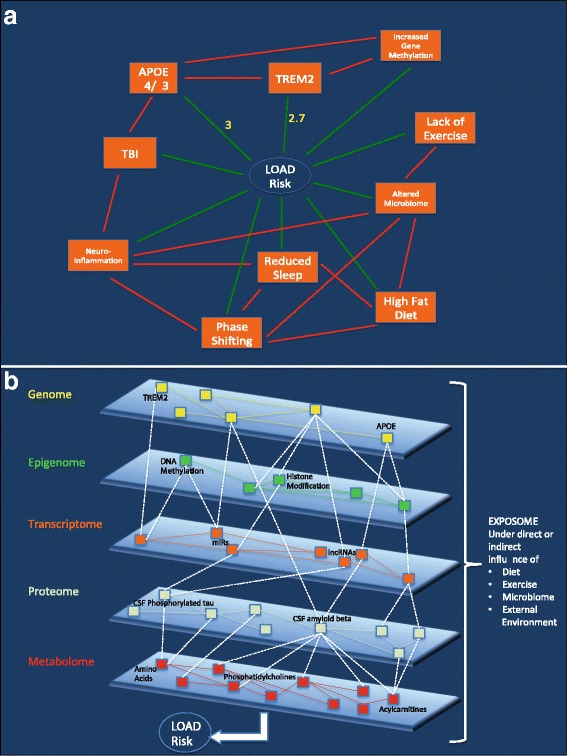Fig. 3.

Systems biological framework associated with example case. Panels a and b represent the 2-dimensional (2D) and 3-dimensional (3D) depictions, respectively, of the relevant internal and external network architecture associated with the case. (a) The clinical features associated with our subject are represented in 2D as nodes (orange rectangles) and edges (lines) directly connecting the nodes to LOAD risk (green), and interacting with other nodes (red). Yellow numerals express known risk relationships between specific nodes and LOAD risk. Note that the majority of edges have no numerical representations and that not all nodes are shown to interact via edges. Edges represent either uni- or bi-directional relationships between nodes, and can provide positive or negative influences. (b) Our example case is now represented in 3D, displaying proposed more holistic relationships for our example subject’s personal multiomic profile and LOAD risk. Note the complex interactions between nodes (small colored rectangles) in each layer of the individual’s intrinsic multiomic matrix, including features specific to this case (in bold black letters – APOE, TREM2, DNA methylation) and other features not specific to this case (in black letters). There are complex, yet to be determined relationships represented within each “omic” layer (solid color edges between nodes), as well as relationships between nodes of alternative “omic” layers (dotted white edges). Together, these nodes and edges embody a multidimensional representation of a complex system of interactions that 1) are unique to the individual, and 2) are under constant influence by external (environmental) factors (i.e. the exposome) acting on various layers of the internal multiomic matrix, in reducing or increasing LOAD risk. LOAD = late-onset Alzheimer’s disease. APOE = apolipoprotein E gene. TREM2 = trigger receptor expressed on myeloid cells 2 gene. CSF = cerebrospinal fluid. miRs = microribonucleic acids. lncRNAs = long non-coding ribonucleic acids
